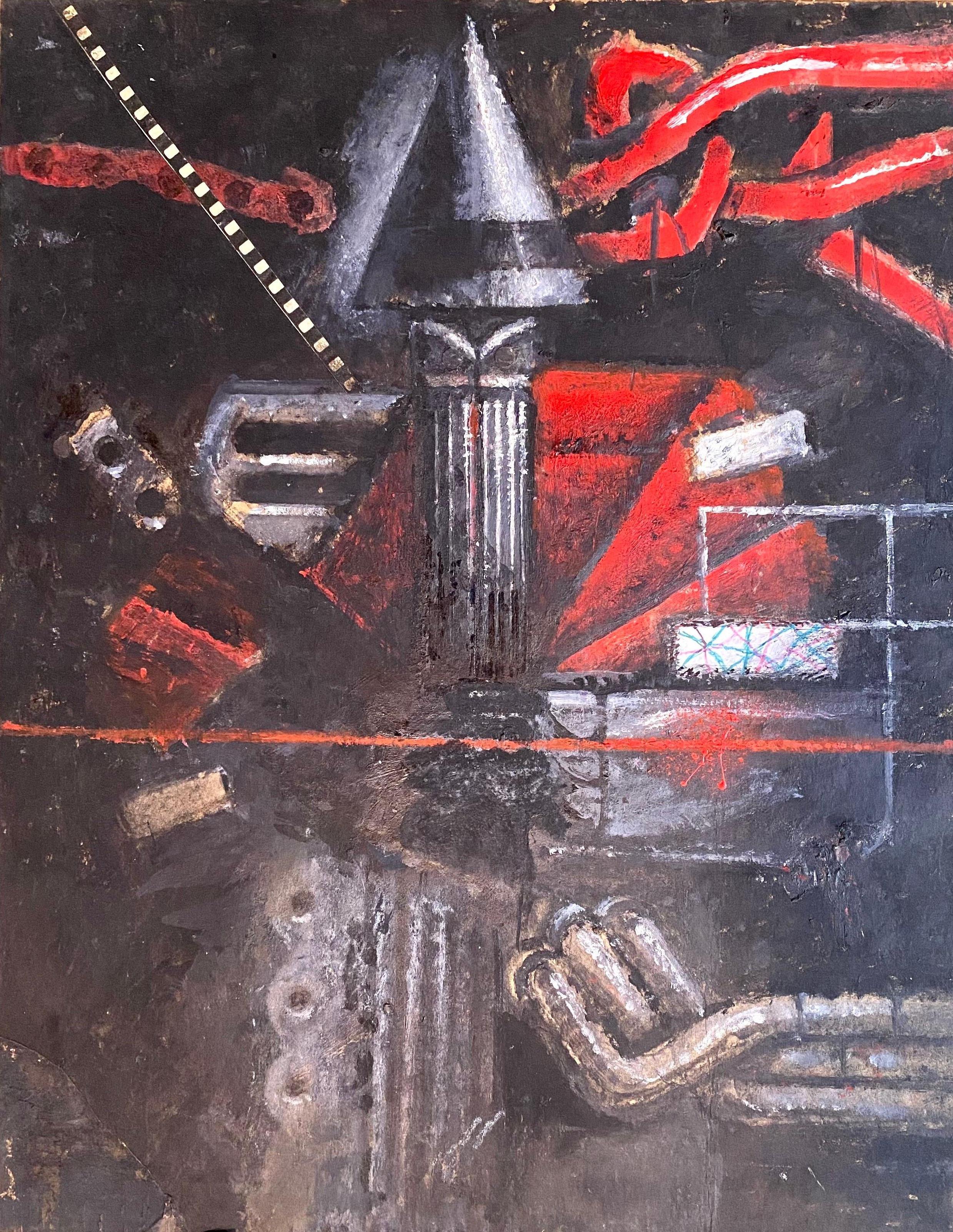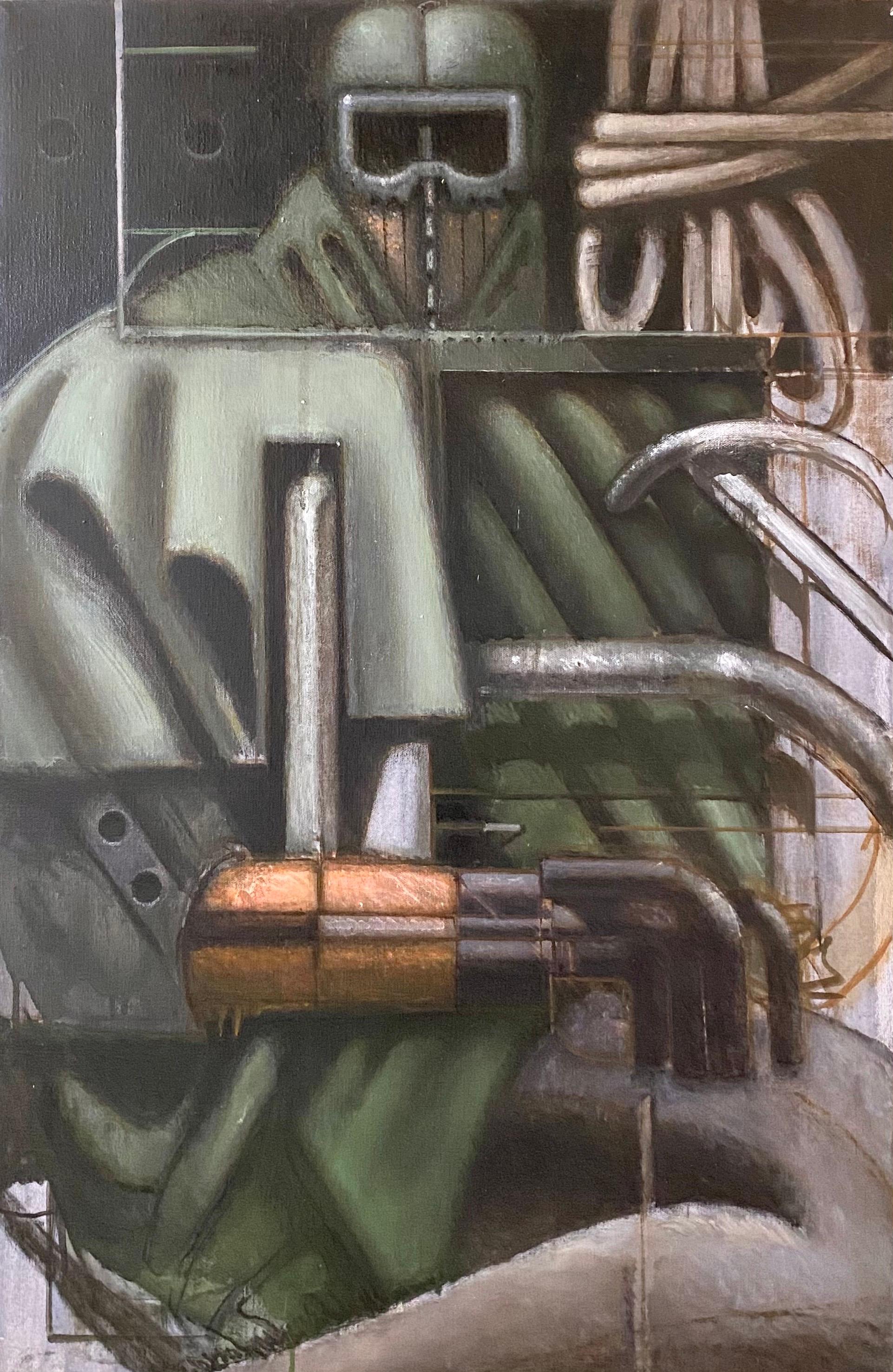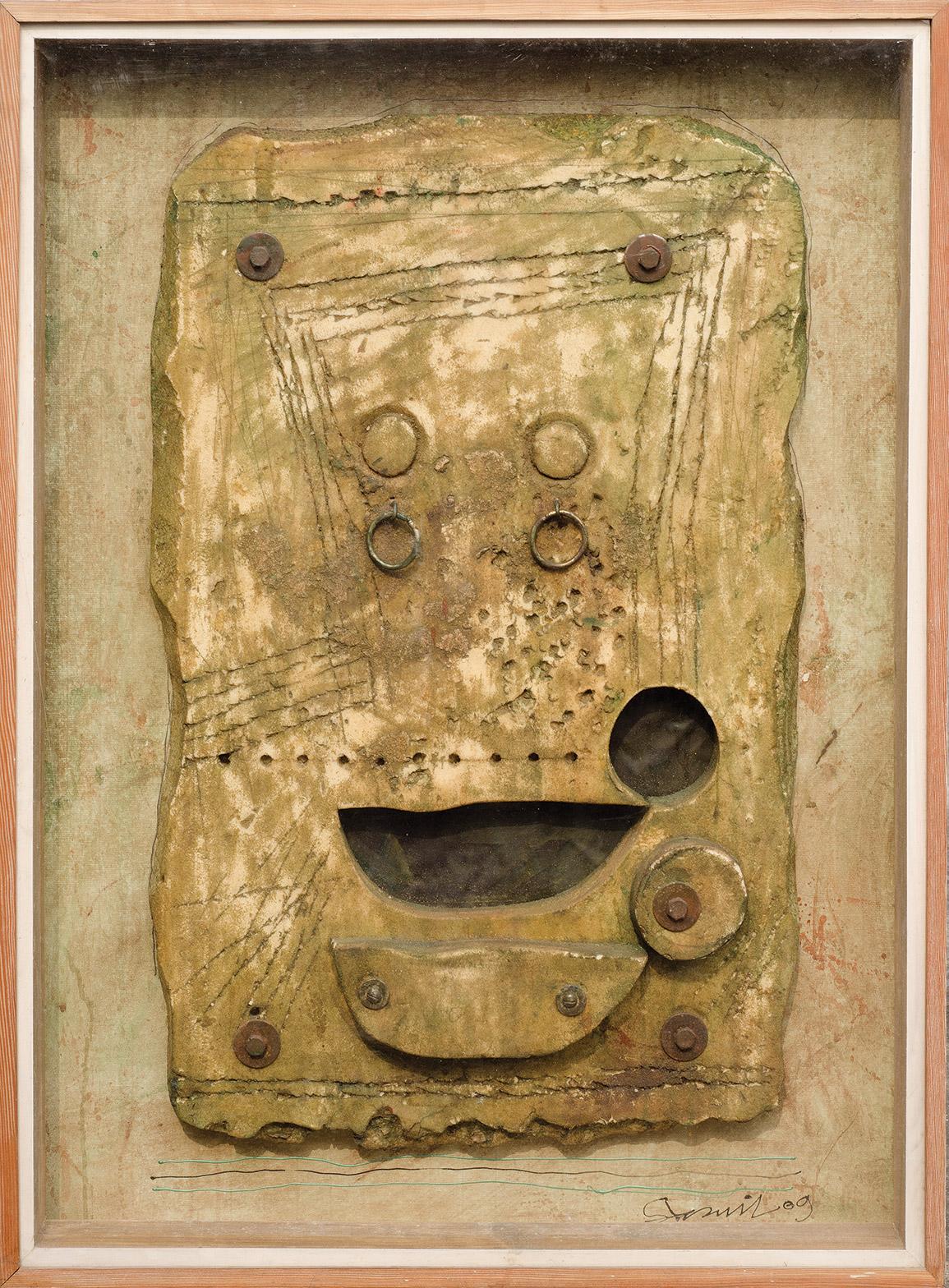Items Similar to Untitled Mid Century Modern abstraction (original signed oil painting on board)
Want more images or videos?
Request additional images or videos from the seller
1 of 13
Remo FarruggioUntitled Mid Century Modern abstraction (original signed oil painting on board)ca. 1947
ca. 1947
About the Item
Remo Farruggio
Untitled Mid Century Modern abstraction (original oil painting), ca. 1947
Oil painting on masonite board
Hand signed by Remo Farruggio on the lower right front
16 × 20 × 1/4 inches
Unframed
This is mid century modern oil painting by the renowned Italian born American abstract artist Remo Farruggio. Done on masonite, the painting is in good condition for its age. Although it is undated, it resembles similar works executed in a geometric style, in a loose series, by the artist in New York in 1945. It's a poignant painting, and the most of the paint loss seen around the edges will frame out.
Remo Farruggio was born in 1904 in Palermo, Sicily. He attended the Galilei Galilec private school in Italy until age 12, at which time, he and his family emigrated to the United States. After settling in New York City, he attended public school and later enrolled in evening classes at the National Academy of Design. In 1922, the artist also attended classes at the Educational Alliance, where he met other prominent artists of the day, including Robert Motherwell, Chaim Gross and the Soyer brothers. Farruggio then attended the Beaux Arts School and the Industrial Arts School, where he studied under the painter Abraham Bogdanov. In 1924, the artist became an American citizen and set out to explore the United States. At the turn of the century, the Great Depression set in, and the government initiated the Works Progress Administration and the Artists Project. Farruggio took part in them both and was ultimately selected as one of two artists chosen for a solo show, which took place in 1939, at the Julien Levy Gallery in NYC. In the years to follow, Farruggio traveled extensively throughout Mexico, the United States and Italy, where he was highly respected and exhibited his work frequently. Beginning in 1964, the artist spent his summers in Provincetown, MA, home to an artist's community where he developed many important relationships in the art world. From the late 1930's to 1981, the artist painted, had several teaching posts and was honored with no less than 20 one-man shows and 25 group shows, winning several important awards along the way. Farruggio's style ranged from representational to semi-abstract to surreal to non-objective. Some of his subject matter included dark, nocturnal, abstracted landscapes or sunlit, atmospheric scenes. Viewing his works, one gets the sense that the artist painted with modesty, grace, elegance and control. Farruggio was a member of the Artists Equity Association of NY, the National Academy of Design and the Provincetown Art Association. His works are included in the permanent collections of more than a dozen museums, including the Metropolitan Museum of Art in NYC and the National Museum of American Art at the Smithsonian Institution, as well as numerous private collections in the US and abroad.
Provenance:
Acquired from the Estate of Remo Farruggio
Good vintage condition with some paint loss and minor flaking (see photos); much of the loss around the edges of the board will frame out
- Creator:Remo Farruggio (1904 - 1981, Italian, American)
- Creation Year:ca. 1947
- Dimensions:Height: 16 in (40.64 cm)Width: 20 in (50.8 cm)Depth: 0.25 in (6.35 mm)
- Medium:
- Movement & Style:
- Period:
- Condition:Good vintage condition with some paint loss and minor flaking (see photos); much of the loss around the edges of the board will frame out.
- Gallery Location:New York, NY
- Reference Number:1stDibs: LU1745213614952
About the Seller
5.0
Platinum Seller
These expertly vetted sellers are 1stDibs' most experienced sellers and are rated highest by our customers.
Established in 2007
1stDibs seller since 2022
306 sales on 1stDibs
Typical response time: 1 hour
- ShippingRetrieving quote...Ships From: New York, NY
- Return PolicyA return for this item may be initiated within 1 day of delivery.
More From This SellerView All
- Early Mid Century Modern Self Portrait by renowned Abstract Expressionist SignedBy Ron GorchovLocated in New York, NYRon Gorchov Historic Self Portrait, 1955-1959 Oil painting on board Hand signed in paint on the upper recto and dated 1955-9 Frame included: held in original vintage artist's frame This work was exhibited at the Sager Reeves Gallery in Columbia, Missouri in their Masters Exhibit in December, 2022, and is reproduced as a full page in their exhibition catalogue. A copy of this catalogue accompanies the artwork. In 2019, the year before Ron Gorchov passed away, Stephen Truax, director of Cheim & Read, his then gallery, passed along details of this extraordinary painting to Gorchov's studio to be included in the forthcoming catalogue raisonne. When shown the work, Gorchov remembered it well, but was amazed that the painting was still in existence after so many years. This historic early self-portrait, done over a period of four years, from 1955-1959, starting when he was only 25 years old reveals Gorchov's distinctive and sophisticated sense of color and form. This is one of the artist's earliest works, and very few works by Gorchov from this era ever appear on the market or are known to remain in existence. It should be in any museum or career retrospective. This work was gifted by the artist to Elthea Rembrandt Peale...Category
Mid-20th Century Modern Portrait Paintings
MaterialsOil, Board
- Lightness (Abstract Expressionist painting), Hand signed and Estate stampedBy Ben WilsonLocated in New York, NYBen WIlson Lightness, ca. 1980 Oil on masonite board 21 × 25 × 3/10 inches Stamped by artist's estate, Hand signed by the artist on the front AND stamped by the artist's estate on the back Unframed Hand signed by the artist on the front and stamped by the artist's estate on the back. Acquired from the Estate of Ben Wilson. This poignant painting is done by the second generation Abstract Expressionist artist Ben Wilson - one of the youngest artists to be given a show at prestigious ACA Gallery in 1940. Ben Wilson was born in Philadelphia in 1913 to Jewish parents who had emigrated from Kiev and settled in New York City. He was educated in Manhattan public schools and graduated from City College in 1935. To gain exposure to a wider range of styles, he also studied at the National Academy of Design and at the Educational Alliance. Admired by critics throughout his long career, Wilson was singled out as a “discovery” by the New York Times art critic Edward Alden Jewel even before his first one-man show at the Galerie Neuf in 1946. His paintings of the ’30s and ’40s were expressionistically rendered, often Biblical parables, filled with what he called “the grief of the intolerable” and reflecting an acute awareness of the agony of the time, from the Holocaust to the Spanish Civil War. A WPA artist who identified strongly with the plight of the Jews in Europe, he relentlessly explored themes of war, torment, and futility in his early decades of painting. When times changed and social pressures subsided, Wilson’s mood lifted. He spent 1952-54 in Paris working at the Academie Julien. During the ’50s his involvement with specific imagery persisted but became more psychological and mythic in orientation. Influenced by Cubism, he created a vocabulary of interlocking shapes and bold, sweeping gestures that served as a transition between his early figurative expressionism and his later abstract constructivist concerns. Towards the end of the decade Wilson reached a crossroads, moving towards abstraction and searching for what he called “a scaffolding under the externals.” By 1960, influenced by the Russian Constructivists, Mondrian, and Abstract Expressionism, Wilson turned to abstraction. Reexamining the basic elements of painting, he evolved his own personal vocabulary and structure, fusing the cerebral and the emotive. He became increasingly experimental, using house paint, sand, and other unorthodox materials in paintings that he worked from all directions, dripping, spraying, stenciling, and collaging. He employed elements of disjunction, repetitions of geometric motifs, linear networks, and complex overlays to create the transparent, multi-layer development of space that characterizes his later paintings. A consummate draftsman, Wilson filled notebook after notebook with drawings that he amplified in his paintings. Eschewing popular movements, Wilson was always one to pursue a personal aesthetic. Despite more than 30 one-man shows and 50 years of teaching, he increasingly withdrew from the gallery scene but continued to paint daily until his death at age 88 in 2001 in Blairstown, New Jersey, where he and his sculptor wife Evelyn...Category
1980s Abstract Expressionist Abstract Paintings
MaterialsOil, Board
- Untitled 1980s pastel colored signed abstract mixed media painting on boardBy Will CottonLocated in New York, NYWill Cotton Untitled abstraction, ca. 1989 Mixed media painting on board Signed by the artist on lower right front Elegant recessed hand made frame Included with artist's original plexiglass bearing his markings on it Stunning, rare early signed abstract work on board by renowned artist Will Cotton in delicious candy-like pastel colors. Floated and framed in a white wood shadow box frame with the artist's original painted plexiglass. Measurements: Framed: 26 x 20 x 2.75 inches Artwork: 23.5 x 17 inches More about Will Cotton Will Cotton (born 1965 in Melrose, Massachusetts, U.S.A.) is an American painter whose work primarily features landscapes composed of sweets, often inhabited by human subjects. Will Cotton lives and works in New York City. Cotton’s works from the 1990s depicted pop icons sourced from contemporary advertisements such as the Nestlé Nesquik bunny. Cotton described his early works in a 2008 interview, saying “My initial impulse to make these paintings really came out of an awareness of the commercial consumer landscape that we live in. Every day we’re bombarded with hundreds, if not thousands of messages designed specifically to incite desire within us.” In 1996, Cotton began to develop an iconography in which the landscape itself became an object of desire. The paintings often feature scenery made up entirely of pastries, candy and melting ice cream. He creates elaborate maquettes of these settings from real baked goods made in his Manhattan studio as a visual source for the final works. Since about 2002, nude or nearly nude pinup...Category
1980s Abstract Mixed Media
MaterialsMixed Media, Acrylic, Board
- Mirage (ex Reader's Digest Art Collection) Op Art Surreal renowned female artistLocated in New York, NYEdna Andrade Mirage (de-accessioned from the Reader's Digest Art Collection), 1988 Original Collage painting on board Signed, titled & dated on the front; the back bears labels from Marian Locks Gallery & Readers Digest Association with inventory (RDA) number Original frame included with collection and gallery labels verso This is a unique work Exquisite 1980s collage on board painting (framed) titled "Mirage" by renowned female Op artist Edna Andrade...Category
1980s Surrealist Abstract Paintings
MaterialsMixed Media, Acrylic, Board
- Old DoorBy Richard AnuszkiewiczLocated in New York, NYRichard Anuszkiewicz Old Door, 1953 Watercolor on paper Signed and dated by the artist on the lower right front 20 × 14 inches Unframed This unique and extre...Category
1950s American Modern Landscape Drawings and Watercolors
MaterialsPaper, Watercolor
- Deep Creek Seeps 10, Minimalist painting inspired by Agnes Martin New Mexico artBy Johnnie Winona RossLocated in New York, NYJohnnie Winona Ross Deep Creek Seeps 10, 2007 Oil paint on acrylic base burnished on Belgian linen Signed twice, dated and titled on the verso; also bears the original Stephen Haller Gallery label\ Canvas is stretched against wooden backing but no outer frame This work was originally sold by the Stephen Haller Gallery which hosted several critically acclaimed, sell-out shows of New Mexico resident Johniie Winona Ross, whose exquisite Minimalist aesthetic really took hold with collectors. The debt to famous New Mexico resident and Minimalist goddess Agnes Martin is obvious, but Winona Ross has a disctinctive style and technique of his own. The process of creating this work was laborious: Ross typically applies as many as 90-100 layers of paint to each canvas, then scrapes the surface with a straight-edged razor to reveal the many layers (and their chronology), and finally burnishing the surface with a Pueblo pottery stone to achieve a soft gloss. Maureen Mullarkey of Studio Matters wrote in 2010: THE LOVELINESS OF JOHNNIE WINONA ROSS' paintings elude translation into either reproduction or verbal description. In 2011, ArtDaily published this announcement from Stephen Haller, publicizing a later exhibition: "Washington Post critic Stephen Parks characterized Ross’s work in this way: “From a distance his canvases appear to be simple, minimal constructions of horizontal stripes with hints of vertical color in the background. Up close the paintings are seen to be extraordinarily beautiful and complex objects that induce a humming meditative state.” Ross grounds his work in the inspiration of the desert of the American Southwest, and borrows techniques from ancient Native American sources, melding them with a distinctly sophisticated and utterly contemporary vision. His use of the Native American technique of burnishing pigment and minerals with a potter’s stone to create a hard surface with a visually warm sheen creates an effect reminiscent of the softening of marble steps...Category
Early 2000s Minimalist Abstract Paintings
MaterialsLinen, Laminate, Mixed Media, Oil, Acrylic
You May Also Like
- Vintage Expressionist Portrait of a Man with a Bowtie Oil on WoodBy Michael PaukerLocated in Soquel, CAExpressive portrait, a caricature of a man with bowtie by Michael Pauker (American, b. 1957). Unsigned, but was acquired with a collection of the artist's work. Another version of th...Category
Late 20th Century American Modern Figurative Paintings
MaterialsOil, Fiberboard
- Mixed Media Collage Oil Painting Futuristic Abstract Expressionist Machine ArtLocated in Surfside, FLNick de Angelis (June 21, 1921 – 2004) was an American artist who lived and worked most of his life in New York City. His work was widely recognized for its excellence until he becam...Category
20th Century Modern Abstract Paintings
MaterialsOil, Board
- Mixed Media Collage Oil Painting Futuristic Abstract Expressionist Machine ArtLocated in Surfside, FLNick de Angelis (June 21, 1921 – 2004) was an American artist who lived and worked most of his life in New York City. His work was widely recognized for its excellence until he becam...Category
20th Century Modern Abstract Paintings
MaterialsOil, Board
- Mixed Media Collage Oil Painting Futuristic Abstract Expressionist Machine ArtLocated in Surfside, FLNick de Angelis (June 21, 1921 – 2004) was an American artist who lived and worked most of his life in New York City. His work was widely recognized for its excellence until he becam...Category
20th Century Modern Abstract Paintings
MaterialsOil, Board
- Abstract, Wood, Iron, Oil & Mixed Media, Green, Black by Indian Artist"In Stock"By Sunil DasLocated in Kolkata, West BengalSunil Das - Untitled - 31 x 20 inches (unframed size) Wood, Iron, Oil & Mixed Media on Board Inclusive of shipment in ready to hang form. Sunil Das (1939-2015) was a Master Modern I...Category
Early 2000s Modern Abstract Paintings
MaterialsIron
- Still Life with Masks, Vintage Semi-Abstract Painting, Red, Pink, Yellow, GreenBy Edward MarecakLocated in Denver, CO"Still Life with Masks", vintage original semi-abstract painting by 20th century Denver artist, Edward Marecak (1919-1993) from 1983. Oil Paint on board with a mid-century modern fe...Category
1980s American Modern Abstract Paintings
MaterialsOil, Board
Recently Viewed
View AllMore Ways To Browse
Mid Century Modern Art Original
Mid Century Modern Oil Paintings
Midcentury Modern Oil Paintings
Geometric Mid Century Modern Art
Midcentury Italian Painting
Original Oil Painting Midcentury
American Mid Century Oil Paintings
Mid Century Oil On Board
Original Abstract Mid Century Modern
American Midcentury Oil Painting
Mid Century Modern Oil Art
Abstract Mid Century Vintage Art
Mid Century Abstract Art Vintage
Mid Modern Dark Art
Oil Painting Mid Century City
Mid Century Italian Abstract
Two Oil Paintings On Board
Depression Modern





